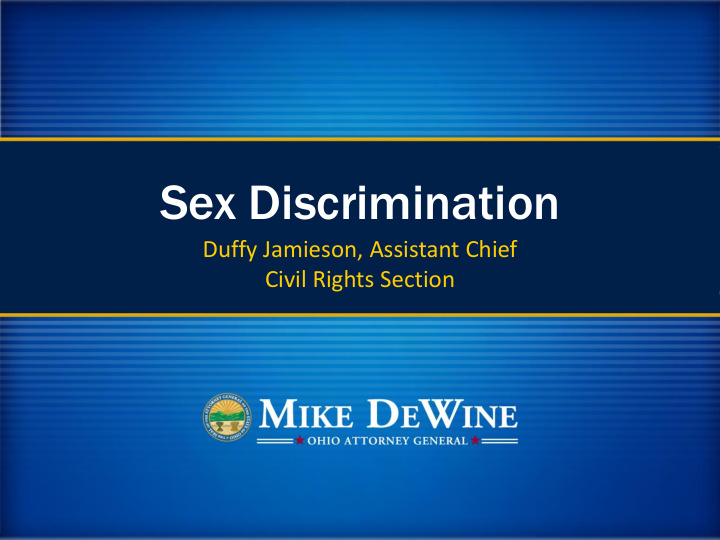



Sex Discrimination Duffy Jamieson, Assistant Chief Civil Rights Section
IMPRESSIONS FROM AN OFFICE – Natasha Josefowitz HE’s getting married He’ll get more settled . HIS desk is cluttered . SHE’s getting married . He’s obviously a hard worker and a busy man . She’ll get pregnant and leave. HER desk is cluttered. She obviously a disorganized scatterbrain. HE’s having lunch with his boss . He’s on his way up . SHE’s having lunch with her boss . They must be having an affair. HE’s having a baby . He’ll need a raise . SHE’s having a baby . She’ll cost the company money in maternity benefits
Why are we still talking about sex discrimination today? How have sex discrimination issues evolved? What laws might apply to sex discrimination issues? What are some best practices to avoid sex discrimination claims?
Sex-Based Charges 35,000 30,000 25,000 20,000 15,000 10,000 5,000 0 2004 2005 2006 2007 2008 2009 2010 2011 2012 2013 2014
Religion National Familial status 2% Origin/Ancestry 2% 4% Age 10% Race/Color 26% Retaliation Disability 20% 20% Sex-Based 16% Percent of Charges Based on Protected Class - 2014
“Pure” Sex Discrimination “Pure” sex discrimination is the treatment of a person unfavorably because of that person’s gender
Sennello v Reserve Life (1987)
Lupi v. Suarez Corp. (1994)
The women were good at their job = pretext The supervisors said and did stupid things = stereotypes
Sex “Plus” Discrimination Sex Plus Child Care Sex Plus Marital Status Sex Plus Extramarital Relations
Not so Better good Do you have child Are you available to care arrangements? work 8:00 to 5:00? Are you available to Are you pregnant? work overtime on occasion? Will you return after What are your long your maternity leave? term goals? Why are you qualified for this job? Are you married? (There is no alternative question)
Sex “Plus” Discrimination Family Responsibility Discrimination Caregiver Discrimination
The “New Normal” – Working Parents 70% - The 40% - The percentage of percentage of children raised in unmarried women families with a who account for single working new births. parent or two working parents. 40% - The 75% - The percentage of percentage of working women women entering who return to the workforce who work within three will become months after their pregnant. pregnancy.
The “New Normal” Aging Parents
Common caregiver scenarios • New Supervisor Syndrome • Second Child Bias • The Elder Care Effect
What type of claims are involved in Caregiver discrimination?
Sex “Plus” Pregnancy
Sex “Plus” Appearance Why courts are reluctant to hold companies liable over dress codes Title VII was designed to combat practices that seriously impair employment opportunities The “plus” was aimed at fundamental or immutable characteristics Most policies with grooming codes are roughly burdensome on both sexes
Corne v. Bausch & Lomb (1975) Tompkins v Public Service (1976) Miller v. Bank of America (1976) Meritor Savings Bank v. Vinson (1986)
Williams v. General Motors (1999) Gender Harassment
Gender Stereotyping Price Waterhouse v. Hopkins (1989)
Transgender Discrimination Smith vs. Salem (2004) Macy v Dept. of Justice (2012)
Sexual Orientation Discrimination Terveer v. Billington (2014) Complainant v. Foxx and the Department of Transportation (2015)
1200 1000 800 600 400 200 0 Gender Identity/Transgender Sexual Orientation Total LGBT Charges 2013 2014 70% Increase in two years
Avoid the appearance of pretext by making decisions based on objective criteria Avoid stereotypes by evaluating employees based on their qualifications
Focus on qualifications Be flexible Keep objective
Recommend
More recommend